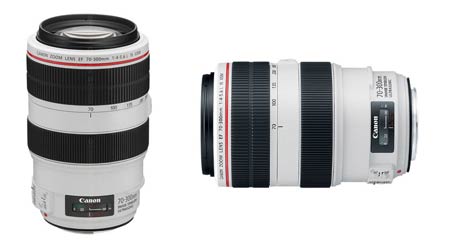This digital photography equipment review from PhotographyTalk.com features the Canon EF 70–300mm f/4-5.6 L USM (67mm filters, 1.2m/4' close-focus, 37.4 oz.). Its “EF” designation refers to the “electronic focus” capability, controlled by an auto-focus motor in the lens. “IS” is image stabilization and “USM” is ultrasonic motor, which makes for a very quiet, virtually silent, auto-focus (AF).

Read real customer reviews of the Canon EF 70-300mm here.
Most digital photographers will find this Canon EF 70–300mm an excellent choice, although many will swallow hard when they see the $1,600 price tag. Nonetheless, it has outstanding optics, superior mechanics, fast auto-focus and friendly ergonomics. The tradeoff on cost is a choice between the Canon 70–300mm IS, which is constructed with many plastic parts, for approximately $550 or the Canon EF, with primarily a metal alloy construction, for three times as much.
Nikon D600 | Nikon D7100 | Nikon D800 | Canon 5D Mark III | Nikon D5200 | Canon 1D X
For some photographers, that difference in lens construction makes the EF worth the price. The zoom ring turns with great precision and trueness, so you can select focal lengths accurately and with very little motion or force of a finger. This is because of its all-metal cams, which are only found on better lens; plastic being the common material.
Another distinctive feature of the Canon 70–300mm L IS, which is quickly evident, is that it is thick and short and white. This improves ergonomics and makes it easy to focus manually. Study those lens rings carefully because zoom is the front ring and focus is the middle ring. You’ll also find a zoom lock at 70mm.
This new Canon lens doesn’t make your older Canon camera models obsolete. Attach it to any Canon DSLR and Canon auto-focus film camera from as far back as 1987.
Additional specs for the Canon EF 70–300mm f/4-5.6 L USM Lens.
Optics
19 elements in 14 groups.
Two of these elements are of ultra-low dispersion (UD) glass.
Multicoated.
Fluorine front coating claimed to be more smudge resistant than previous coatings.
Internal focus: nothing moves externally as auto-focused.
Image Stabilization
Rated 4 stops improvement.
Angle of View
34º – 8.25º (on 35mm and Full-Frame).
Diaphragm
70–300mm f/4-5.6 IS at f/4.5 and 135mm. (EF diaphragm not visible).
8 rounded blades.
Stops down to f/32–45.
Close Focus
3.9 feet (1.2m), marked, from the image plane.
Maximum Reproduction Ratio
1:4.8.
Infinity Focus Stop
Not available. You must let the AF system focus for you at infinity.
Focus Scale
Yes, but only vestigial.
The ring turns from near to far within approximately 120º.
Depth-of-Field Scale
No.
Infrared Focus Index
For 200, 100 and 70mm.
Filter Thread
67mm.
Metal.
Does not rotate, but does move in and out with zooming.
Size
Canon specifies 3.5" (89mm) diameter by 5.6" (143mm) long.
The front extends as one zooms to 300mm.
Weight
37.415 oz. (1,060.7g), measured.
Canon specifies 37.0 oz. (1,050g).
Case
LP1414 sack, included.
Caps
Standard 67mm ET-67U front, included.
Standard EOS cap rear.
Tripod Collar
Optional $190 Tripod Collar (p/n 4429B001) not included.
Introduced
March 2011
For some photographers, that difference in lens construction makes the EF worth the price. The zoom ring turns with great precision and trueness, so you can select focal lengths accurately and with very little motion or force of a finger. This is because of its all-metal cams, which are only found on better lens; plastic being the common material.
Another distinctive feature of the Canon 70–300mm L IS, which is quickly evident, is that it is thick and short and white. This improves ergonomics and makes it easy to focus manually. Study those lens rings carefully because zoom is the front ring and focus is the middle ring. You’ll also find a zoom lock at 70mm.
This new Canon lens doesn’t make your older Canon camera models obsolete. Attach it to any Canon DSLR and Canon auto-focus film camera from as far back as 1987.
Additional specs for the Canon EF 70–300mm f/4-5.6 L USM Lens.
Optics
19 elements in 14 groups.
Two of these elements are of ultra-low dispersion (UD) glass.
Multicoated.
Fluorine front coating claimed to be more smudge resistant than previous coatings.
Internal focus: nothing moves externally as auto-focused.
Image Stabilization
Rated 4 stops improvement.
Angle of View
34º – 8.25º (on 35mm and Full-Frame).
Diaphragm
70–300mm f/4-5.6 IS at f/4.5 and 135mm. (EF diaphragm not visible).
8 rounded blades.
Stops down to f/32–45.
Close Focus
3.9 feet (1.2m), marked, from the image plane.
Maximum Reproduction Ratio
1:4.8.
Infinity Focus Stop
Not available. You must let the AF system focus for you at infinity.
Focus Scale
Yes, but only vestigial.
The ring turns from near to far within approximately 120º.
Depth-of-Field Scale
No.
Infrared Focus Index
For 200, 100 and 70mm.
Filter Thread
67mm.
Metal.
Does not rotate, but does move in and out with zooming.
Size
Canon specifies 3.5" (89mm) diameter by 5.6" (143mm) long.
The front extends as one zooms to 300mm.
Weight
37.415 oz. (1,060.7g), measured.
Canon specifies 37.0 oz. (1,050g).
Case
LP1414 sack, included.
Caps
Standard 67mm ET-67U front, included.
Standard EOS cap rear.
Tripod Collar
Optional $190 Tripod Collar (p/n 4429B001) not included.
Introduced
March 2011
This article about "Canon EF 70–300mm f/4-5.6 L USM" was first published on our website here
https://www.photographytalk.com/photography-equipment-reviews/555-digital-photography-equipment-reviewcanon-ef-70300mm-f4-56-l-usm